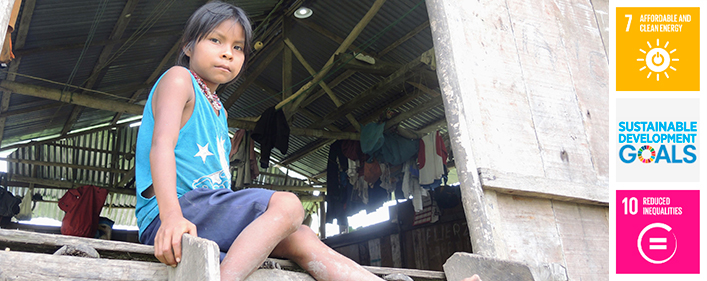- The customer survey conducted in the 61 households attended with the Luz en Casa Amazonia Pilot Project has revealed their total satisfaction with the service of the photovoltaic systems provided.

In 2015, the ACCIONA Microenergia Foundation started a new electricity service delivery model that is adapted to Amazonian communities, in the Peruvian department of Loreto. It began to be implemented with the ‘Luz en Casa Amazonia’ Pilot Project, which has been co-funded by the National Fund of Scientific, Technological and Technological Innovation Development of Peru (so called FONDECYT).
With this project the acceptability of that innovative model has been evaluated in four communities of the Napo district. This model is based on the multi-stakeholder management, involving users and local authorities, the payment of an affordable fee for service, and the technology of pay-as-you-go third-generation solar home systems (PAYG-3GSHS).
These systems include three lamps and connections for mobile charging and compatible 12V devices. Their technical sustainability is based on the Centro Luz en Casa opened at the locality of Santa Clotilde (capital of the Napo district), where the users go to buy compatible devices and receive information, advice and repair services for the systems.
ACCIONA Microenergia has recently conducted a survey concerning the service brought to the 61 families that have electricity, since February 2016, with the ‘Luz en Casa Amazonia’ Pilot Project. It has shown: 100% of families satisfied or very satisfied with the systems, consider it is easy to use it (100%), install it (88%), as well as handle the prepayment (88%). 98% of surveyed people are saving on their monthly expenditure in energy, and 100% of them consider the service given by ACCIONA Microenergia as good and they recommend it.
That is, they confirm the acceptability of the proposed model to bring electricity to the Amazonian communities; providing access to basic electricity services to those communities is characterized by extreme logistical difficulties to which this new delivery model gives a satisfactory response.
Other interesting results of that survey, that confirm various positive impacts on the life of the communities a few months after having electricity, are:
- Households use the provided electric lighting for an average of 6 hours daily.
- The main uses for that lighting are study (67%), work (43%) and preparation of meal (21%).
- More hours for children education and adults’ productive activities will end in higher education levels and incomes.
- And making easier to carry out domestic task, users (specially women) can use saved time for other educative, productive, or entertainment activities.
- Many families have left the use of alternative lighting elements such as torches (79%), oil lamps (30%) and candles (25%).
- Leaving the use of those elements, which provoke smokes and whose light have not enough intense, eye and lung diseases are reduced.
- In addition, there is a positive environmental impact, in this area of high ecologic value, due to remove the use and so the uncontrolled disposal of batteries, as well as avoid the emission of CO2 by displacing the electricity from diesel generators with photovoltaics.
Once the pilot project ends with this validation of both the delivery model and the technology, a new project starts so as to extend the action to a great part of the Napo river basin, with its users attended from the Centro Luz en Casa at Santa Clotilde.